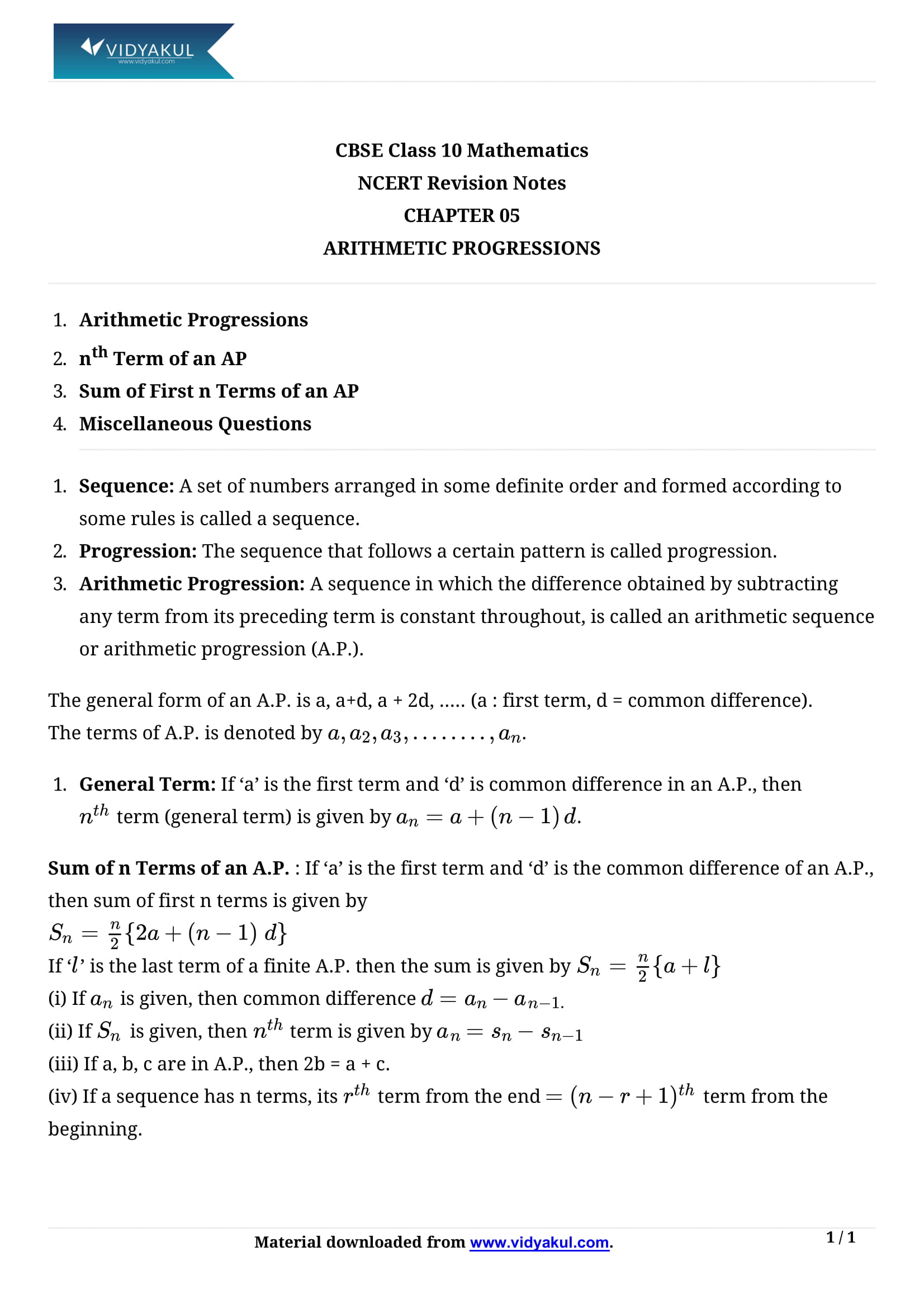Arithmetic Progressions Class 10 Notes

Chapter 5 Arithmetic Progressions
Chapter 5 of the Grade 10 Mathematics Program covers arithmetic progression. This is an important chapter covered in Lesson 10 and is divided into 5 main sections. We recommend that students read these topics very carefully in order to learn, absorb and retain all the information provided by the solution. Our experienced tutors have invested time in developing solutions that best fit the needs of students so that they can score well on their exams.
MATHEMATICS NOTES CLASS 10th CH-5
Points to Remember
We have provided a few important points that are covered in NCERT Class 10 Maths Chapter 5 to help students in their exam preparations. Refer to the points below:
A sequence is a finite or infinite list of numbers following a specific pattern. For example, 1, 2, 3, 4, 5,… is the sequence, an infinite sequence of natural numbers.
A series is the sum of the elements in the corresponding sequence. For example, 1+2+3+4+5….is the series of natural numbers. Each number in a sequence or a series is called a term.
A progression is a sequence in which the general term can be can be expressed using a mathematical formula.
In arithmetic progression, the first term is represented by the letter “a”, last term is represented by “l”, the common difference between two terms is represented by “d” and the number of terms is represented by the letter “n”.
Thus, the standard form of the arithmetic progression is given by the formula,
a, a + d, a + 2d, a + 3d, a + 4d, ….
Now, consider the infinite arithmetic progression 2, 5, 8, 11, 14….
Here, first term, a = 2
Common difference = 3
The difference between two consecutive terms in an AP, (which is constant) is the “common difference“(d) of an A.P. In the progression: 2, 5, 8, 11, 14 …the common difference is 3.
As it is the difference between any two consecutive terms, for any A.P, if the common difference is:
positive, the AP is increasing.
zero, the AP is constant.
A finite AP is an A.P in which the number of terms is finite. For example the A.P: 2, 5, 8……32, 35, 38
An infinite A.P is an A.P in which the number of terms is infinite. For example: 2, 5, 8, 11…..
The formula for the sum to n terms of an AP
The sum to n terms of an A.P is given by:
Sn= n/2(2a+(n−1)d)
Where a is the first term, d is the common difference and n is the number of terms.
The sum of n terms of an A.P is also given by
Sn= n/2(a+l)
All the formulas related to Arithmetic Progression class 10 are tabulated below:
Topics and Sub-topics
In NCERT notes Class 10 Chapter 5 Mathematics, students learn about arithmetic progression. The NCERT notes PDF for Chapter 5 of Grade 10 Mathematics, free of charge, can help students achieve good grades. Students can download this PDF by visiting Vidyakul. This file has been prepared by leading academic experts in India. Each answer is written according to the rules set by CBSE. We also do everything we can to ensure that our students get good grades.
The following table has been provided to give the students a glimpse at the important topics that are covered in the chapter on Arithmetic Progressions:
A sequence is a finite or infinite list of numbers following a specific pattern. For example, 1, 2, 3, 4, 5,… is the sequence, an infinite sequence of natural numbers.
A series is the sum of the elements in the corresponding sequence. For example, 1+2+3+4+5….is the series of natural numbers. Each number in a sequence or a series is called a term.
A progression is a sequence in which the general term can be can be expressed using a mathematical formula.
In arithmetic progression, the first term is represented by the letter “a”, last term is represented by “l”, the common difference between two terms is represented by “d” and the number of terms is represented by the letter “n”.
The difference between two consecutive terms in an AP, (which is constant) is the “common difference“(d) of an A.P. In the progression: 2, 5, 8, 11, 14 …the common difference is 3.
positive, the AP is increasing.
zero, the AP is constant.
A finite AP is an A.P in which the number of terms is finite. For example the A.P: 2, 5, 8……32, 35, 38
An infinite A.P is an A.P in which the number of terms is infinite. For example: 2, 5, 8, 11…..
The formula for the sum to n terms of an AP
All the formulas related to Arithmetic Progression class 10 are tabulated below:
Learn more about this in Arithmetic Progressions Class 10 Notes pdf.
Download Latest Class 10 Sample Papers 2019 for Board Exams
- CBSE Class 10 Sample Papers 2019 PDF
- CBSE Class 10 Maths Sample Papers 2019 PDF
- CBSE Class 10 Science Sample Papers 2019 PDF
- CBSE Class 10 English Sample Papers 2019 PDF
- CBSE Class 10 Hindi Sample Paper 2019 PDF
- CBSE Class 10 Social Studies Sample Papers 2019 PDF
Download this solution for FREE Download this PDF




